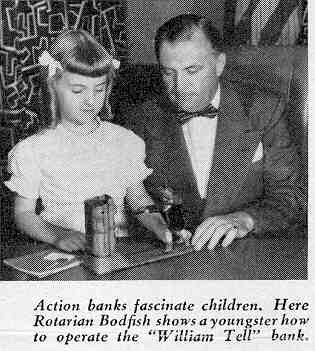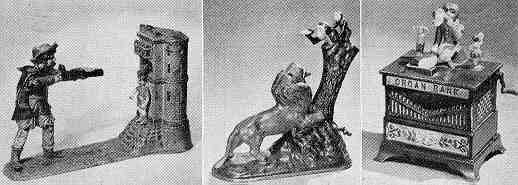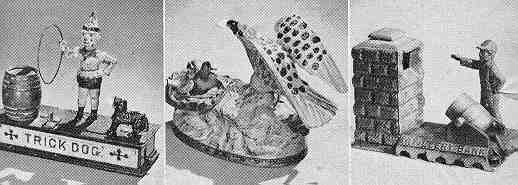Hobby Hitching Post
THE ROTARIAN -August, 1950
THE hobby of MORTON BODFISH, a Chicago, Illinois Rotarian, makes
possible this statement about him: He is president of a savings association - and owner of
some 150 banks. But before you visualize a chain of branch banks stretching across the
United States, read ROTARIAN BODFISH'S story about the 150 banks he owns.
 YES it's true that I own about 150 banks, but
they're not the kind that offer savings accounts, loan departments, safe-deposit vaults,
and other facilities. They are miniature mechanical coin banks, and they comprise my
collection of ingenious cast-iron devices that deposit coins in a clever and frequently
amusing way.
YES it's true that I own about 150 banks, but
they're not the kind that offer savings accounts, loan departments, safe-deposit vaults,
and other facilities. They are miniature mechanical coin banks, and they comprise my
collection of ingenious cast-iron devices that deposit coins in a clever and frequently
amusing way.
For instance, there is my "Bulldog" bank, set on an oblong base. The coin is
placed on the dog's nose and when his tail is pulled, the lower jaw drops forward and the
coin falls into his mouth. My "Artillery" bank shoots the coin from a mortar
into a blockhouse opening when a lever is pressed. The bank called "Indian Shooting
the Bear" is more intricate, with an Indian warrior, feathers and all, holding a gun
that shoots the coin into the chest of a bear standing by a tree stump.
If you have by now deducted that all the banks in my collection "do something,"
you're right. By means of levers, springs, rollers, cranks, or other moving parts, these
banks perform synchronized movements in the process of depositing coins placed at a
designated spot. Banks built simply to hold coins inserted by hand in slots are known
among collectors as "still" or "dumb" banks. My banks are mechanical
ones, the first of which was invented in 1869 by a New Englander.
The theory behind the mechanical bank and its "trick" way of placing a coin in a
receptacle was to encourage thrift among youngsters. Fascinated by the action of such
banks, children needed no coaxing to save their pennies, nickels, dimes, or whatever coin
their bank was built to accommodate. When these banks were popular a few generations ago,
they were manufactured by several foundries in the Eastern part of the United States and
sold for varying nominal amounts. Today they are so rare that avid collectors have been
known to travel many miles to obtain a particular bank for their collection at a cost of
several hundred dollars.

My interest in mechanical banks can't be traced like the pursuits of many
hobbyists to a definite moment in my life, nor to a particular experience. As a boy, we
had a few of the banks in our home, but their period of great popularity had passed and my
interest in them was no more than casual. It wasn't until I entered the savings field that
these toy like contrivances for saving coins made a hobbyist of me.
Like many other collectors of rare items, I have done my share of searching the shelves
and counters of antique shops and exploring slightly musty attics for a type of mechanical
bank I have heard or read about, but do not possess. Of course, all the early vintage
banks have only relative values, and the extremely rare ones are frequently worth about
half of what the collector is willing to pay. But the serious collector of mechanical
banks - and there are quite a few members of this fraternity - will gladly pay 50 times
the original selling price for an exceptionally rare item.
In my collection are several items which I especially prize. One is called the
"Dentist" bank. The action involves a patient sitting in a chair and a dentist
poised in the well-known tooth-pulling position. As the dentist pulls the tooth, he falls
over backward causing the coin placed in his pocket to drop into a gas-bag receptacle
mounted on the base, while the chair and the patient both tip over in the opposite
direction.

Music, also, plays a part in the action of some of these mechanical
marvels. A bank which I obtained in Switzerland belongs in this category, and is one of
the largest items in my collection. Built along the architectural lines of a Swiss chalet
with several doors and windows, its intricate mechanism plays a tune called The Reindeer
Polka, while a miniature dog and reindeer swing to and fro from their recessed positions
within the chalet. Another is the "Organ" bank that chimes as a crank is turned.
Atop this one are a seated monkey, and a boy and girl who revolve like dancers as the
music plays.
Most of the mechanical coin banks manufactured in the '80s and '90s can be said to be
products of the imagination and ingenuity of their designers; others, however, portray
legendary or Biblical events and famous personages, both real and fictional. There is the
"Jonah and the Whale" bank, with the coin instead of Jonah being tossed into the
whale's mouth; the "William Tell" bank which shoots the traditional apple off a
boy's head with a coin that goes sailing into a castle; and others which feature Santa
Claus, Theodore Roosevelt, General Ulysses S. Grant, Punch and Judy, and Christopher
Columbus.
A study of the intricate handiwork incorporated in banks of this type, their ingenious
construction, and their clever movements, usually leads even the most
"unmechanically-minded" person to realize that these cast-iron automatons are
certainly among the cleverest of all moving novelties. In a mechanical-bank collection,
the observer sees not only lifelike precision movements produced by skilled mechanicians,
but also well-proportioned design, amusing action, and the application of psychology to
the habit of thrift.
As a savings and loan association manager, I find that my coin-bank collection is
satisfying in many ways. And I have observed that it holds interest for people in many
fields of business activity. I know this to be true, for in the lobby of the savings
association with which I am associated in Chicago, I have my collection on display in a
glass showcase, and through most people have important personal transactions on their
minds, they still take a little time to look at the collection. I must admit that I like
to watch them.
And speaking of things I like, if it's a coin bank and it moves - I like it.
